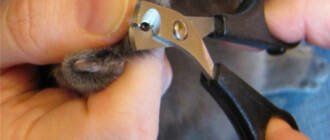A sign of trouble may be the animal's desire to hide away from everyone.
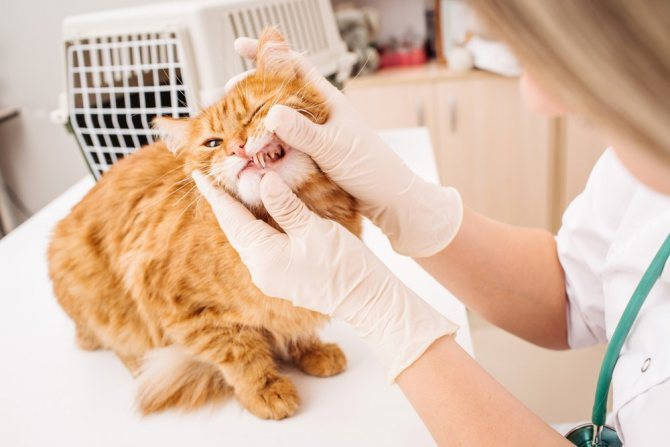
- A cat has a broken tooth: what to do?
- Diagnosis of broken teeth in a cat
- Prevention
- Tooth resorption in cats
- Cat breaks tooth, what to do?
- What to do if a cat has a broken piece of tooth?
- A detailed description of common causes
- Treatment
- Preventive measures
- Fractured teeth: to treat or not to treat?
- Methods of treatment
- Treatment
A cat has a broken tooth: what to do?
Cats need regular oral care. But even the most careful care of a cat's teeth sometimes does not save from tooth loss or similar injuries. What to do if a cat's tooth breaks?
To begin with, let's define right away: if a tooth has fallen out in a kitten who is 3-5 months old, it's not a big deal at all. He's just replacing milk teeth with molars. But if an adult cat breaks a tooth, it's already serious.
A tooth consists of several layers: the outer, white layer is called enamel. It is the thinnest. The second layer, under the enamel, is dentin, which forms the base of the tooth and is responsible for its hardness. The third layer, also called the inner layer, is called the pulp. The pulp hides arteries, veins, and nerves.
Any or all of the three layers can be damaged. Damage can be of several kinds: a tooth can crack, break off, or fall out altogether. In any case, the owner first needs to understand what is wrong with the cat.
It is not easy to do, because the animal may not show much concern for a long time. First of all, you should pay attention to how the animal eats.
If the cat has become less likely to touch its food or stops eating when it has barely begun, this is an alarming symptom. Keep in mind that eating disorders can lead to digestive problems.
Also, a cat with a broken tooth may start hiding from its owner for fear that his touch will hurt it. If the problem with the tooth is serious, the cat's muzzle may swell.
Perform an initial examination of the tooth: pay attention to the nature of the chipped tooth. Some injuries do not require immediate medical attention, and the cat can live comfortably with a chipped tooth for a while.
If you can see blood on the tooth, it means that not only the enamel and dentin are damaged, but also the pulp. This condition is much more dangerous because infection can enter the wound. Pay attention to whether the neighboring teeth or gums are affected.
In any case, treatment for such injuries is done at a veterinary clinic, so at the first sign that your cat has broken a tooth, take her to a doctor who can determine the extent of the damage.
Diagnosis of broken teeth in a cat
To fully assess a broken tooth, the veterinarian will take an x-ray of the cat's mouth. A complete oral examination will also be performed to evaluate the overall condition of your cat's mouth.
Treatment will depend on the extent and severity of the cat's injury. Crowns and other additional dental services may be used to repair the damaged tooth, including surgery if the damage is severe.
Removal may be recommended if the tooth or root cannot be repaired, followed by sealing the affected area with restorative material or lining.
In many cases, it is recommended to limit the cat's activities until it has fully recovered. At this time, the cat's diet should consist mostly of wet foods.
Prevention
Do not allow the cat to chew on very hard substances, such as stones, as this can damage the structure of the tooth or cause it to break. Also, cats that are allowed to roam freely are at higher risk than those that are in an isolated and safe environment.
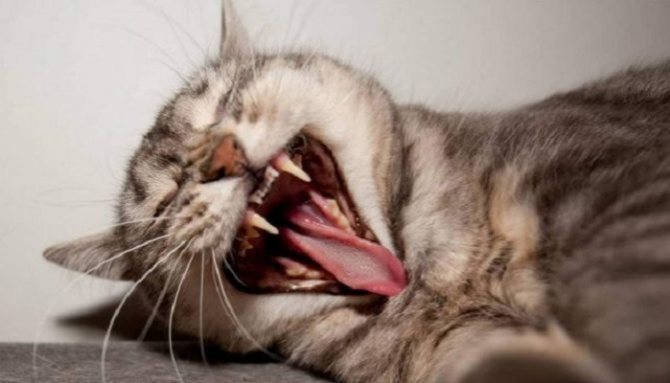
Tooth resorption in cats
Cat breaks tooth, what to do?
A cat broke a tooth. Noticed it just today. He's aggressive with us, always biting me. But today when he tried to bite me – all shuddered and stopped for a minute. Several times he tried – the same thing. My jaw was shaking. I looked, and his upper fang is broken (the very edge). Yesterday he jumped off the refrigerator. When he landed, he made strange movements with his mouth, as if he was biting the air. I didn't pay much attention to it, I thought he was trying to catch a piece of paper which flew off the fridge after him.
In general, as I understand it – to bite it hurts.
Who's had this happen? Not taken to the vet yet. The cat is not one year old.
The author, I still advise you to show the cat to the vet (preferably a dentist)!
It depends on how the tooth is chipped, it may cause discomfort to the animal, it may become inflamed and it doesn't matter if the cat is a purebred or not!
It's better to have such a tooth removed!
The most dangerous situation is if a cat's tooth breaks. This is especially true for important teeth, such as canines. In this case, treatment will already be useless. Urgent extraction is necessary. If this issue is not taken care of in time, the root that is left of the tooth will fester right in the gum. It is not possible to relieve inflammation with pills and improvised remedies all the time.
Experienced professional veterinarians have all the necessary equipment and medications to treat and remove damaged teeth.
How much will the treatment/removal cost approximately?
Maman may not want to drive him. She told me today:
– Valya told me at work that her cat had the same thing and nothing. I'm thinking of taking her to the doctor myself.
The vet. clinic is in two cities, I live in a village. I feel bad for the cat, I do not know what to do? He is only a year old by human standards.
What to do if a cat has a broken piece of tooth?

Even a young, perfectly healthy cat can have a chipped tooth. It can happen not only while eating, but also while playing with other animals. It is also common for chipped teeth to occur after a fall from a great height or a collision with hard surfaces (an accident). In young pups, this phenomenon does not cause any health concerns, but it is still worth seeing a veterinarian to rule out the development of gum-related diseases. In adults, the same symptom can be considered serious, as there is a risk of developing pathologies such as gingivitis and periodontal disease.
A detailed description of common causes
Noticing that a piece of a cat's tooth has chipped off at once is almost impossible, because even the calmest pets by nature are not very eager to let their mouths be examined. Most often the problem is discovered accidentally – when the pet yawns or sleeps with its mouth open. Worse, when the problem is signaled by symptoms such as bad breath, pain while eating or bleeding gums. When a cat has chipped teeth, the following circumstances and conditions should be kept in mind:

- Trauma. Most often, cats have their teeth chipped during the first two years of life, when they are still learning the world around them. It can be a fall from a great height, collisions with hard surfaces, accidents. Rarely, chipping can occur while eating, even if it is very hard bones. Animals naturally have very strong teeth. But, unfortunately, this does not apply to cats of elite breeds, which from birth are prone to develop periodontal disease and gingivitis. In most cases small chips do not affect their health and may never bother them. If the tooth is chipped at the root, however, a visit to the dentist is in order. If the root is not removed immediately, there is a high chance of developing an abscess or fistula on the gum.
- Deep decay. Over time, it can cause a piece of the affected tooth to break off. It usually does not bother the animal in any way for a long time, and the owner may not even be aware of the problem. Typical symptoms are a yellowing of the enamel on the teeth (mostly canines), bleeding of the gums near one or more teeth, refusal to eat solid food (usually it hurts to chew dry food). Early tooth decay can be caused by poor diet (the diet contains many soft foods of vegetable origin) or congenital predisposition (Maine Coons, Sphinxes and Persians are in the risk group). Treatment in each case is individual, as much will depend on the breed of cat, the nature, the extent of the process and age. In most cases, the procedure is performed under anesthesia, so that the animal can in no way interfere with the dentist to perform their work properly. In advanced cases, it may be necessary to remove the affected tooth to eliminate the risk of future root problems (root cysts, root abscesses). Prevention of dental caries should start from the first months of a cat's life so that it becomes accustomed to this procedure from childhood and is not afraid of it. Breeds that are congenitally predisposed to the development of tooth decay are recommended to have a dental hygiene cleaning at least once a year.
- Tartar. A common problem not only for all animals, but also for humans. Some ornamental breeds have problems with dental enamel deposits from the first days of life. Lack of regular brushing and mechanical removal of tartar can lead to disastrous consequences. Therefore, if a cat has a chipped tooth, brown plaque on the enamel, foul odor from the mouth, or bleeding gums, you should rule out the possibility of tartar. In such cases, the best option is to go to a dentist who can assess the extent of the process and perform the necessary hygiene procedures. Namely, the teeth are cleaned of calculus using ultrasound or special dental instruments. After the procedure, a protective paste is applied to the enamel. After that, the doctor must explain how to brush your pet's teeth on their own and what kind of food is best to use. Breeds such as Maine Coon, Abbey, Siamese, Persian and Scottish should have their tartar removed at least once a year.
Treatment
This process depends on the nature of the damage. Damaged dentin is treated with fluoride and sealant. If the canine is more severely damaged and no treatment can return it to a healthy state, it will be removed.
Recommended article: How to protect a cat from toxoplasmosis: routes of infection, symptoms, treatment and prevention.
In some cases, a seal is placed on the animal. Special plates are used if the case is a crack of small size. If the crack appeared because the jaw was injured and there were abrasions and scratches in addition to problems with the teeth, the jaw is treated first. The veterinarian is able to put the tooth back in its original place if it has shifted. In this case, the main thing is to immediately go to the veterinary clinic, because an inflammatory process can begin.
Cats quickly adapt to life without a canine, and it will not affect his abilities and behavior in any way. The animal will be able to chew food with ease and the absence of the canine will not bring discomfort.
Preventive measures
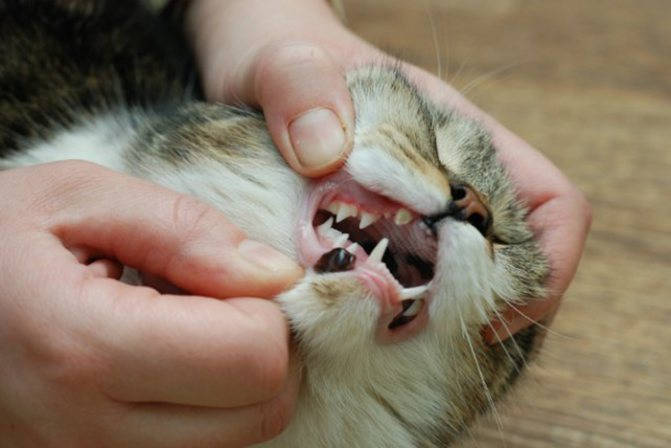
It is necessary to resort to removal only in case of severe injuries. A veterinarian performs the procedure harmlessly for the cat, using special equipment and anesthetics.
If the displacement is not critical, it is left in place. The animal will not be bothered by such a deviation. If your pet's behavior changes and he acts like something is in the way and tries to pull it out with his paw, you should go to the vet for a checkup. The tooth will be put back in its former place and it will become invisible again. Do not try to do this procedure yourself, you may cause your cat pain and develop an infection and inflammation.
You need to have your cat's mouth checked and cared for regularly. Brushing your cat's teeth will help prevent many diseases, not only for humans but also for animals. You should keep this in mind and carefully clean the cavity once a week. Also, taking vitamins systematically will improve the health of the body and the condition of the teeth. They are mixed with food and given to the animal for a month once a year. After removal, it is important to continue care and examination. Until the healing process is complete, there is a risk of complications.
Sometimes this prolapse begins because of an improper diet. You should feed your pet only natural foods, not what you eat yourself. The wrong diet causes problems not only with the teeth, but also with the intestines.
If a cat has a chipped canine at an early age, the owner shouldn't worry. There is a change of teeth, in place of which new ones will grow. The main thing is that the fallen piece did not get into the food. If such a symptom appears, watch the kitten and do not try to pull the tooth with improvised means, you will only aggravate the natural process.
It is important to check your cat's mouth regularly, and you may prevent serious diseases before they start. If your pet frequently goes outdoors, pay attention to any abrasions or scratches on its face, as these may not be the only ones. It is better to seek help from a specialist right away, so you can reduce the pain and get rid of the ailment more quickly.
Fractured teeth: to treat or not to treat?
Does your pet have broken teeth? Are you unsure of the answer? Not in the habit of looking your pet in the mouth? Do you think getting your cat's or dog's teeth filled is something out of the realm of science fiction? And you should! Let's try to explain why.
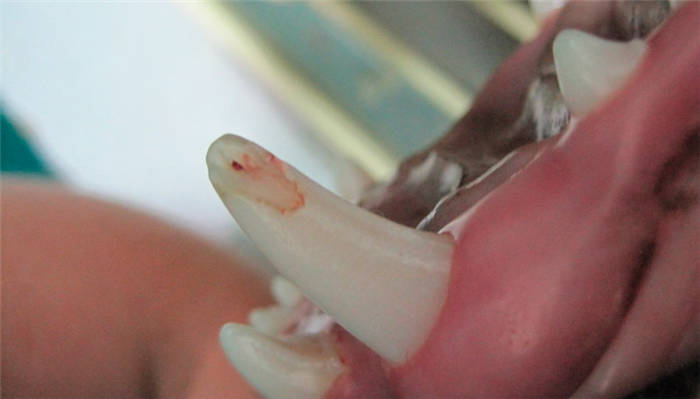
Teeth take the full dynamic load of the animal's daily activities like playing, working and eating. Because of their relative inflexibility, teeth often break. The extent of this fracture is determined on a case-by-case basis and can be as minor, when no treatment is necessary, or as severe, when endodontic therapy (work in the tooth canal) or extraction of the tooth is required.
A tooth consists of three main parts: the pulp, dentin and enamel. The pulp is the deepest part of the tooth and consists of vessels and nerves that provide nutrition and sensation to the tooth.
It should be noted that the nerve fibers inside the pulp are responsible for only one feeling – pain. There are two types of pain receptors in the pulp, one responsible for a piercing sharp pain and the other for a dull throbbing pain. This is especially important in cases where the pulp is opened (fractured tooth). It is difficult to even approximate the degree of pain experienced by animals with such fractures who have not received proper dental care for months or even years. Even though over time the pulp becomes infected and necrotic (dies). Your pet's acute pain is blunted, but you should always remember that an open pulp cavity is the gateway to infection.
If your pet has a broken tooth that has an open pulp cavity, it's bound to end up with periostitis (flus) or even osteomyelitis (purulent inflammation of the jaw). And it's only a matter of time. It may take more than one year since the injury, but the result is the same (and it is inevitable) – removal of the tooth, opening of the abscess, treatment of the fistula. And all of this in an emergency, because purulent processes in the body severely disturb the overall condition.
Methods of treatment
Treatment options when a cat's canine is broken off, depending on the degree of damage. If only the din – the middle layer was damaged, the veterinarian covers the tooth with a special sealant or fluoride. These substances serve as protection against infection of the pulp, and they also minimize pain. If severe damage has been diagnosed, the cat's canine is broken under the root, it must be removed. If the damage to the element is very deep and reaches the inner layer – the pulp, it is shown to fill the nerve canal and close with a crown.
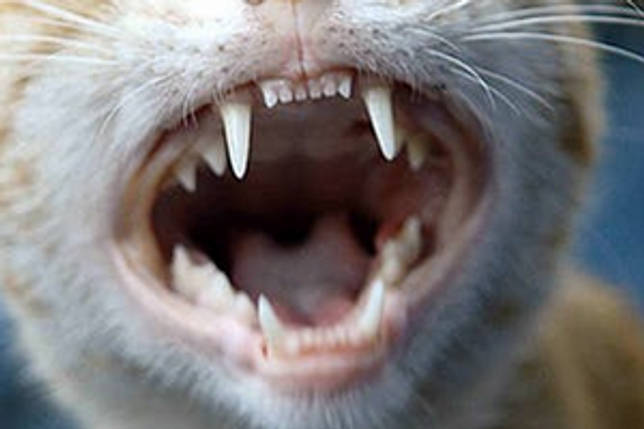
If the owner noticed small cracks on the surface of the canines, you should immediately go to the veterinary clinic. In this case, the application of special plates is required to eliminate the loss. If the fracture was caused by trauma to the jaw, it is the jaw injuries that are the first to be treated. In severe situations, the tooth is displaced from its socket. It is required urgently to put it in place. The doctor then chooses a way to fix the element in position.
Caring owners should not worry too much about a lost fang in their pet. It should be understood that cats do not eat with their fangs. They are only a tool for hunting. Pets do not need this type of teeth, as they do not have to get their own food. Animals quickly get used to the new conditions of chewing food without fangs. The only thing to worry about is the consequences if the diseased canine is not treated in time. Infection and inflammation can occur. To prevent severe cases, it is necessary to treat your pet's oral diseases in a timely manner. A healthy pet will please its owner for a long time.
Treatment
This process depends directly on the nature of the damage. Damaged dentin is treated with fluoride and sealant. If the canine is more damaged, and no way to return to a healthy state – it is removed.
Recommended article: In a cat with blood in the feces: causes, treatment and prevention
In some cases, the animal is installed a filling. Special plates are used if the case is a crack of small size. If the crack appeared from the fact that the jaw was traumatized and in addition to problems with the teeth there were abrasions and scratches, the jaw is treated first. The veterinarian is able to put the tooth back in its original place if it has shifted. In this case, the main thing is to immediately go to the veterinary clinic, because an inflammatory process may begin.
Cats quickly adapt to life without a canine and it will not affect their abilities or behavior in any way. The animal will be able to chew food with ease and the absence of the canine will not bring discomfort.





